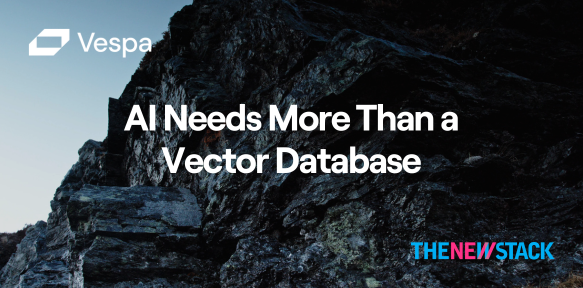AI Needs More Than a Vector Database

Interest in vector databases is skyrocketing, as evidenced by Google Trends data. In its latest report, Vector Databases Landscape, Q2 2024 Forrester highlights over 20 vector databases, classifying them into two main categories: specialized native vector databases and multimodal databases that integrate vector storage within a broader data ecosystem.
Native vector databases are designed for optimal scale and performance, while multimodal databases offer the versatility to handle multiple data types, reducing the complexity of managing separate systems. For a deeper dive into leading native vector databases, refer to the GigaOm Sonar Report for Vector Databases.
A vector database is a specialized database designed to store, manage and query high-dimensional vectors, which are crucial for applications that retrieve content by semantic similarity. Emerging in the late 2010s, interest in vector databases has been driven by generative AI, as they enable fast and accurate similarity searches essential for tasks like recommendation systems, natural language processing and image recognition, thereby significantly enhancing AI application quality and versatility.
While vector databases are considered the key to generative AI, vectors alone are just one piece of the larger puzzle. Achieving relevant answers in generative AI relies on a robust and comprehensive search capability powered by machine learning algorithms that detect patterns in historical data, predict outcomes, identify anomalies and recommend actions.
This must be done across billions of rapidly changing data points, with results delivered instantly (<100 milliseconds) while supporting large user populations, potentially executing thousands of queries per second. Although some data may be vectors, most business applications require integrating and analyzing unstructured data, such as PDFs, alongside traditional structured data to generate vectors.
Given this complexity, focusing solely on a vector database can miss the broader picture. According to Forrester, you choose a best-of-breed vector database but must then integrate the necessary components, such as machine learning, support for non-vector data types, and workload management for performance and high concurrency. Or you can choose a multimodal database that at least provides broader data types but requires fitting in with an application set it was never designed to support.
Enter the AI Database
A new type of database is emerging: the AI database. An AI database is a multipurpose platform that, in addition to vectors, also manages structured and unstructured data. It applies AI models to various data formats, combining signals for more accurate outputs. The AI database enhances computing efficiency and supports scalability by consolidating models and data types. It organizes data by clustering similar vectors in query results and supporting compliance while also searching tables, text and vectors for specific values, document matches and similarity searches to generate inferences using AI models.
AI databases support three primary AI model types: functions approximating machine learning (ML), natural language processing (NLP) and generative AI.
- ML models find patterns in historical data to predict trends, identify anomalies, rank/score results and recommend actions. They primarily select data like tables, text or images for further use.
- NLP models interpret and generate text or speech for tasks like translation or sentiment analysis, mainly processing text files.
- Generative AI models generate content such as text, images, audio or video based on existing data, predicting the next elements in a sequence.
These models, often hosted and run within the AI database, learn patterns, make inferences and create outputs based on the data they receive. If you want to know more about AI databases, I recommend this report from BARC for a deeper dive into the AI database.
The AI database represents a significant advancement, yet it remains only a partial solution due to its lack of application logic and runtime management. To meet generative AI’s demanding scale and latency requirements, substantial effort is needed to integrate tools and optimize runtime performance. The most effective approach is a platform that seamlessly combines data, application logic and large-scale execution, offering a comprehensive solution that addresses all these critical needs.
Vespa: An Open Source AI Engineer’s Platform
Vespa.ai is an open source platform for developing and running real-time AI-driven applications for search, recommendation, personalization and retrieval-augmented generation (RAG). Vespa efficiently manages data, inference, and logic, supporting applications with large data volumes and high concurrent query rates. It’s available as a managed service and open source. Learn more about Vespa here.
This blog was originally published in The New Stack
